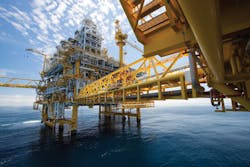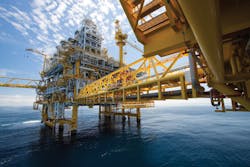Proposed rule seeks stricter well control regulations
Sarah Parker Musarra
Editor
On April 17, 2015, the Bureau of Safety and Environmental Enforcement (BSEE) announced its new proposed BOP and well control requirements rule for the outer continental shelf federal waters, 30 C.F.R. Part 250. Several years in the making, it aims to enhance well control and equipment reliability, and includes a suite of reforms in well design, well control, casing, cementing, real-time well monitoring, and subsea containment.
“While we have current requirements related to well control, BOP equipment, and well control equipment, this represents a major upgrade in existing regulations,” BSEE’s Chief of Offshore Regulatory Programs Doug Morris toldOffshore.
Currently undergoing BSEE’s in-house review as the agency works to produce the final version, once completed, the proposed rule will go before the US Office of Information and Regulatory Affairs in the US Office of Management and Budget for finalization. Although BSEE is unable to say at this time when the final rule will be published, the agency said that it expected to finish its review soon.
Post-Macondo standards
Morris said that the rule has been under development since 2012. The impetus for its drafting, however, reaches back even further.
Following theDeepwater Horizon tragedy, several groups headed investigations that resulted in sets of recommendations being made to the industry. The proposed rule says that these investigations found “a need to enhance well control best practices to advance safety and protection of the environment.” In 30 C.F.R. Part 250, BSEE intends to bolster these recommendations by formalizing them into legal requirements. Additionally, the agency has incorporated guidance from its formal communications to operators and contractors, which are termed Notices to Lessees and Operators.
“We had a lot of recommendations arising out ofDeepwater Horizon, some of which related to blowout preventers, and some of which related to issues like drilling margins,” Morris said. “To the extent we could, we tried to address those issues within this proposed rule-making.” He said that hundreds of Macondo-related recommendations were captured in this rule.
BSEE is also looking to close existing gaps with the new rule, thereby strengthening the cohesion between its regulations and industry standard practices, especially with regard to BOP testing and reliability. Included in the new rule are several post-Macondo industry standards to establish minimum requirements for the design, manufacture, repair, and maintenance of BOPs. Of the eight American Petroleum Institute (API) and American National Standards Institute (ANSI) standards included in the new rule, five are specifically related to BOP systems.
Bureau officials regularly attended industry meetings with these standard-setting organizations during their post-Macondo reviews, Morris said, explaining that this participation helped the agency when drafting the proposed well control rule.
The proposed rule will also allow the US regulator to enact more control over BOP repair and maintenance. Under 30 C.F.R. Part 250, a BSEE-approved third party will be required to review the repair and maintenance records related to BOP equipment annually. The rule stipulates that the people performing BOP maintenance work must be “qualified and trained pursuant to original equipment manufacturer recommendations.” The traceability of this equipment and its critical components is a key point in the new rule; the third-party equipment audit is one way that BSEE is seeking to ensure it, even if the equipment is serviced or repaired outside federal jurisdiction. The bureau also doubles the current BOP pressure testing interval for workover/decommissioning operations from 7 days to 14. BOP testing frequency for drilling/completions operations remain at a testing interval of 14 days. BSEE estimated that this provision would save the industry $150 million a year, noting that “the cost savings benefit of the proposed rule would result in benefits greater than the identified quantitative costs of the rule.”
The complete breakdown and detailed inspection of the BOP in an interval not to exceed every five years is a regulatory requirement under 30 C.F.R. Part 250. This is currently an industry standard.
Another focus of the proposed rule centers on shear rams. For example, double shear rams have become an industry baseline standard for most operators under API Standard 53, “Blowout Prevention Equipment Systems for Drilling Wells.” As one of the API and ANSI standards incorporated in the proposed rule, BSEE is again seeking to make an industry standard compulsory.
BSEE also tried to enhance API Standard 53 and the others incorporated into the rule when necessary. For example, under the proposed rule, an operator could report to the original equipment manufacturer (OEM) with the appropriate data if there was to be a problem with that OEM’s BOP.
“What it will do, effectively, is help prevent problems from occurring and becoming really big problems, like if we had to do a full recall of a certain thing,” BSEE Associate Director Allyson K. Anderson toldOffshore. “They’ll see it early on; if they needed to adjust any of their manufacturing specs, they will be able to do so.”
Some aspects of drilling operations will also be affected by 30 C.F.R. Part 250. BSEE is seeking to require the real-time monitoring of certain drilling activities, including operations in shallow-water that are deemed high-risk; deepwater; and high-pressure/high-temperature operations. The agency is also seeking to adopt more detailed criteria for safe drilling margins that are in line with recommendations made by Department of Justice and Office of the Inspector General following Deepwater Horizon.
In addition to the cost savings the agency associated with the BOP testing interval change, BSEE named the reduction in oil spills, fatalities, and time savings as benefits of the rule, and concluded “the societal benefits would justify the societal costs.”
Feedback and collaboration
As a matter of procedure, governmental branches that potentially stand to be affected by a proposed rule will have an opportunity to formally review and comment upon it. However, BSEE reached out to other governmental agencies and attempted to work with the industry during the drafting process, prior to the formal intergovernmental review, Anderson said.
“Well before the intergovernmental review, we tried to reach out and actively engage our counterparts to make sure that everything we were doing made sense; is consistent; and does not have conflicting policies with any other agency,” she explained.
BSEE also held a BOP workshop to receive industry feedback. From this, Anderson said that BSEE was able to gauge where the whole of the industry was in adopting these standards, which in turn allowed the agency to determine the rule’s effective dates. For most components of 30 C.F.R. Part 250, operators will be required to demonstrate compliance within the 90 days following the rule’s publication.
“Having a three-month phase-in makes a whole lot of sense when the input that we received on the front-end was very positive, in terms of how they are already complying with their standards,” Anderson explained.
There are some notable exceptions, and for these, BSEE has included a staged set of effective dates that reach years into the future. Operators will have three years from the time of the rule’s publication to comply with the real-time monitoring requirements. The installation of double rams on subsea BOPs and surface BOPs on floating production systems must be completed within five years, while operators will have seven years to install shear rams that center drill pipe during operations.
Industry reaction
Several industry trade associations worked together to formally submit a 200-page document of technical comments and recommendations to BSEE on the proposed well control rule: the API, the International Association of Drilling Contractors (IADC), the Independent Petroleum Association of America, the National Ocean Industries Association, the Offshore Operators Committee, the Petroleum Equipment & Services Association, and the US Oil and Gas Association.
The 216-page-long missive says that it is the result of tens of thousands of hours logged by more than 300 subject matter experts from over 70 companies
In the document, jointly submitted to BSEE, these organizations said that their members agreed that operations “must be conducted safely and in a manner that protects the environment.” However, it said that its associations’ members would be “adversely impacted by this BSEE rulemaking.”
The API spoke out against what it and others have called the “one-size-fits-all” approach of the rule, noting that the risk management based process currently employed by the industry allows a well to be designed and operated according to the needs of that particular well.
Also chief among their points to BSEE was that the new rules did not take into account any of the improvements made across the industry following Deepwater Horizon and “instead establishes prescriptive new requirements that would impose unjustified economic burdens.”
These organizations also stated that many of the rule’s provisions “lack articulated rationale,” citing a part of the rule concerning the better definition of the drilling margin.
“The proposed rule does not discuss how the current requirements are insufficient, how the new requirements were determined, or how these requirements would improve offshore drilling safety,” the trade associations said.
Because work on the rule is still under way, BSEE was unable to comment on any specific proposed changes to the drilling margin. However, Morris said that the targets were based on recommendations from the Department of Justice following Deepwater Horizon, which aimed to better clarify what the target should be for operators while drilling wells.
API also said it believed that the implementation timeframe proposed in the rule was “unrealistic, effectively creating a drilling moratorium in the interim.” The standards-setter said that new equipment cannot feasibly be manufactured, produced and installed within that timeframe, and additionally noted that drilling rigs could need to be re-engineered to accommodate this equipment.
Cost is another issue. Quest Offshore and Blade Energy Partners prepared a well control rule cost and economic analysis for the API. The analysis found an estimated 10-year cost of the rule totaling $31.8 billion, with $15.7 billion of that total projected to be used toward well design, tubing, and equipment.
In the economic analysis included in the rule, BSEE estimated its 10-year incremental cost at around $883 million.
BSEE said that it received a great deal of feedback during its comment period following the proposed rule’s introduction.
“We are carefully addressing all of the input received during the comment period in order to ensure due diligence on that part,” a spokesperson from BSEE toldOffshore. “There were approximately 175 commenters, which amounted to 5,000 pages of comments.”
December Senate hearing
Several offshore industry organizations were present on Dec. 1, 2015 when the US Senate Committee on Energy & Natural Resources, chaired by Lisa Murkowski (R-Alaska), heard testimony from BSEE Director Brian Salerno, API Director Erik Milito, and others, on the proposed rule.
“It is abundantly clear that despite post-Macondo improvements in safety and technological advancements, there are still issues that must be addressed in order to see an appreciable decrease in dangerous loss of well control incidents,” Salerno said in his testimony. “The proposed well control rule represents a concerted effort to address these issues and reduce risk offshore.”
API’s Milito expressed concerns that the rule could increase risk and decrease offshore safety and emphasized that the industry wanted to work with BSEE on the rule. After the hearing, other industry bodies, including IADC, NOIA, and others, released statements confirming that their respective organizations would work with BSEE on the rule, and urging the regulator not to rush the final rule.
Closing his testimony, Salerno emphasized that the bureau was taking its time in reviewing all industry comments, and related findings.
“We have heard the concerns about drilling margins, blowout preventer inspections, accumulator capacity, and real-time monitoring,” Salerno said. “We have heard the concerns about the use of prescriptive language and about the potential, unintended consequences of the rule. The bureau must now go through the process of reviewing the technical input received and determine how the text can be revised to best serve the interests of safety, environmental protection, and resource conservation.”

